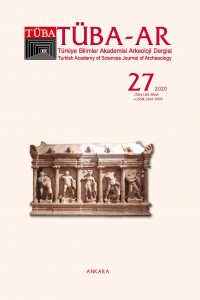PAINTED POTTERY WEST OF THE KIZILIRMAK: NOTES ON CHRONOLOGY AND SUPRA-REGIONAL CONTACTS AT THE TURN OF THE 3RD TO THE 2ND MILLENNIUM BC
Abstract
Keywords
References
- ARIK, R.O. 1939. “Anadolunun En Garp Eti İstasyonu Karaoğlan Höyüğü”, Belleten III/9: 27-42.
- BERTRAM, J.-K./ILGEZDİ BERTRAM, G. 2018. “The Later Prehistory of the Ankara Region”, Context and Connection. Studies on the Archaeology of the Ancient Near East in Honour of Antonio Sagona. Orientalia Lovaniensia Analecta 268 (Eds. A. Batmaz/G. Bedianashvili/A. Michalewicz/A. Robinson). Leuven/Paris/Bristol: 847-865.
- BERTRAM, J.-K./İLGEZDİ BERTRAM, G. in press. The Late Chalcolithic and Early Bronze Age in Central Anatolia. Introduction – Research History – Chronological Concepts – Sites, their Characteristics and Stratigraphies. İstanbul.
- DENİZLİ, H./KAYA, V./ÇETİN, N. 2002/2003. “2002 Yılı Külhöyük Kazı Çalışmaları”, Anadolu Medeniyetleri Müzesi 2002 Yıllığı: 5-27.
- DENİZLİ, H./KAYA, V./ÇETİN, N. 2006. “2005 Yılı Külhöyük Kazı Çalışmaları”, Anadolu Medeniyetleri Müzesi 2005 Yıllığı: 9-34.
- GUNTER, A.C. 1991. The Bronze Age. Gordion Excavations Final Reports III. Philadelphia.
- KAMIŞ, Y. 2012. Acemhöyük Erken Tunç Çağı Seramiği. Unpublished PhD-Thesis Gazi Üniversitesi. Ankara.
- LLOYD, S./GÖKÇE, N. 1951. “Excavations at Polatli. A New Investigation of Second and Third Millennium Stratigraphy in Anatolia”, Anatolian Studies I: 21-75.
- ÖKTÜ, A. 1973. Die Intermediate-Keramik in Kleinasien. München.
- ÖZDEMİR, M.A. 2016. Nevşehir Suluca Karahöyük Demir Çağı Boyalı Seramikleri. Unpublished MA-Thesis Atatürk Üniversitesi. Erzurum.
- ÖZGÜÇ, T. 1947. “Typical Pottery of the Middle Anatolian "Copper" and "Bronze" Ages (New Finds from Kültepe near Kayseri)”, Artibus Asiae 10/4: 312-323.
- OMURA, S. 1991. “Painted Pottery Collected from the Basin of the Delice River in Central Anatolia”, Near Eastern Studies. Dedicated to H.I.H. Prince Takahito Mikasa on the Occasion of His Seventy-Fifth Birthday. Bulletin of the Middle Eastern Culture Center in Japan V (Eds. M. Mori/H.Ogawa/M. Yoshikawa). Wiesbaden: 279-292.
- ORTHMANN, W. 1963a. Die Keramik der Frühen Bronzezeit aus Inneranatolien. Berlin.
- ORTHMANN, W. 1963b. Frühe Keramik von Boğazköy aus den Ausgrabungen am Nordwesthang von Büyükkale. Berlin.
- ORTHMANN, W. 1966. “Untersuchungen auf dem Asarcık Hüyük bei Ilıca”, Istanbuler Mitteilungen 16: 27-88.
- TEMİZSOY, İ./KAYA, V./ÇETİN, N. 2002. “2001 Yılı Külhöyük Kazı Çalışmaları”, Anadolu Medeniyetleri Müzesi 2001 Yıllığı: 5-28.
- VON DER OSTEN, H.H. 1937. The Alishar Hüyük Seasons of 1930-32. Part I. Chicago.
- YILDIRIM, T. 2014. “Çorum / Resuloğlu Kazıları 2013 Yılı Sonuçları”, 4. Çorum Kazı ve Araştırmalar Sempozyumu: 1-9.
PAINTED POTTERY WEST OF THE KIZILIRMAK: NOTES ON CHRONOLOGY AND SUPRA-REGIONAL CONTACTS AT THE TURN OF THE 3RD TO THE 2ND MILLENNIUM BC
Abstract
This article presents dark (black/black-brown) and bichrome (black/black-brown and red) painted pottery appearing west of the Kızılırmak in the late Early Bronze Age and during the transition to the Middle Bronze Age. The pottery originated from the excavations at Karaoğlan Höyük, Polatlı Höyük, Gordion, Külhöyük, and Çayyolu Höyük. The dark-painted pottery might be connected to the Intermediate ware and emerged at the mentioned sites at the end of the Early Bronze Age and during the transition to the Middle Bronze Age. Two groups (Çayyolu Bichrome Ware A and B = ÇBW A and B) which differ in their motifs (simple lines and hatched bands) have been distinguished in the bichrome-painted pottery. Both bichrome groups are local phenomena and appear at about the same time as the black/black-brown-painted ceramics. A supra-regional comparison of ÇBW A and B with other ceramic groups is difficult, but a comparison with Alişar III-pottery might be possible.
References
- ARIK, R.O. 1939. “Anadolunun En Garp Eti İstasyonu Karaoğlan Höyüğü”, Belleten III/9: 27-42.
- BERTRAM, J.-K./ILGEZDİ BERTRAM, G. 2018. “The Later Prehistory of the Ankara Region”, Context and Connection. Studies on the Archaeology of the Ancient Near East in Honour of Antonio Sagona. Orientalia Lovaniensia Analecta 268 (Eds. A. Batmaz/G. Bedianashvili/A. Michalewicz/A. Robinson). Leuven/Paris/Bristol: 847-865.
- BERTRAM, J.-K./İLGEZDİ BERTRAM, G. in press. The Late Chalcolithic and Early Bronze Age in Central Anatolia. Introduction – Research History – Chronological Concepts – Sites, their Characteristics and Stratigraphies. İstanbul.
- DENİZLİ, H./KAYA, V./ÇETİN, N. 2002/2003. “2002 Yılı Külhöyük Kazı Çalışmaları”, Anadolu Medeniyetleri Müzesi 2002 Yıllığı: 5-27.
- DENİZLİ, H./KAYA, V./ÇETİN, N. 2006. “2005 Yılı Külhöyük Kazı Çalışmaları”, Anadolu Medeniyetleri Müzesi 2005 Yıllığı: 9-34.
- GUNTER, A.C. 1991. The Bronze Age. Gordion Excavations Final Reports III. Philadelphia.
- KAMIŞ, Y. 2012. Acemhöyük Erken Tunç Çağı Seramiği. Unpublished PhD-Thesis Gazi Üniversitesi. Ankara.
- LLOYD, S./GÖKÇE, N. 1951. “Excavations at Polatli. A New Investigation of Second and Third Millennium Stratigraphy in Anatolia”, Anatolian Studies I: 21-75.
- ÖKTÜ, A. 1973. Die Intermediate-Keramik in Kleinasien. München.
- ÖZDEMİR, M.A. 2016. Nevşehir Suluca Karahöyük Demir Çağı Boyalı Seramikleri. Unpublished MA-Thesis Atatürk Üniversitesi. Erzurum.
- ÖZGÜÇ, T. 1947. “Typical Pottery of the Middle Anatolian "Copper" and "Bronze" Ages (New Finds from Kültepe near Kayseri)”, Artibus Asiae 10/4: 312-323.
- OMURA, S. 1991. “Painted Pottery Collected from the Basin of the Delice River in Central Anatolia”, Near Eastern Studies. Dedicated to H.I.H. Prince Takahito Mikasa on the Occasion of His Seventy-Fifth Birthday. Bulletin of the Middle Eastern Culture Center in Japan V (Eds. M. Mori/H.Ogawa/M. Yoshikawa). Wiesbaden: 279-292.
- ORTHMANN, W. 1963a. Die Keramik der Frühen Bronzezeit aus Inneranatolien. Berlin.
- ORTHMANN, W. 1963b. Frühe Keramik von Boğazköy aus den Ausgrabungen am Nordwesthang von Büyükkale. Berlin.
- ORTHMANN, W. 1966. “Untersuchungen auf dem Asarcık Hüyük bei Ilıca”, Istanbuler Mitteilungen 16: 27-88.
- TEMİZSOY, İ./KAYA, V./ÇETİN, N. 2002. “2001 Yılı Külhöyük Kazı Çalışmaları”, Anadolu Medeniyetleri Müzesi 2001 Yıllığı: 5-28.
- VON DER OSTEN, H.H. 1937. The Alishar Hüyük Seasons of 1930-32. Part I. Chicago.
- YILDIRIM, T. 2014. “Çorum / Resuloğlu Kazıları 2013 Yılı Sonuçları”, 4. Çorum Kazı ve Araştırmalar Sempozyumu: 1-9.
Details
| Primary Language | English |
|---|---|
| Subjects | Archaeology |
| Journal Section | Research Articles |
| Authors | |
| Publication Date | December 31, 2020 |
| Submission Date | November 10, 2020 |
| Published in Issue | Year 2020 Issue: 27 |
Cite
The contents of this system and all articles published in Journal of TÜBA-AR are licenced under the "Creative Commons Attribution-NonCommercial-NoDerivatives 4.0".



